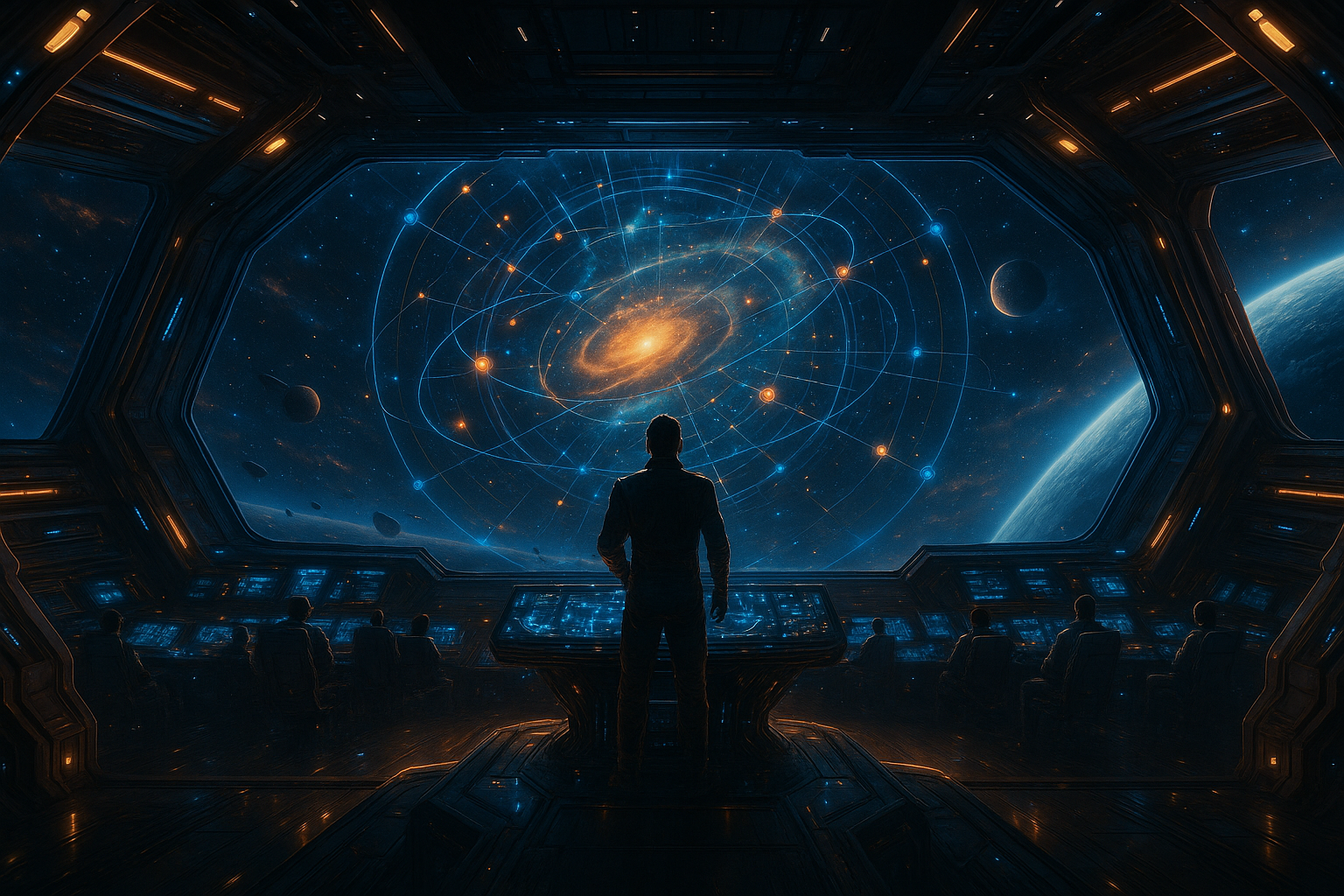- Blog
Global Popular PC Gaming Monitors — TOP 20 Recommendations

Table of Contents
ToggleBelow is a list of 20 of the most popular and PC-gaming-ready monitors on the global market today, spanning 24–34 inches, Full HD to 4K resolution, 144Hz–360Hz and even higher refresh rates, and IPS, VA, and OLED panels. Each product includes detailed specs, key technologies, industrial design, pros & cons, pricing and release timing, usage recommendations, and buying links to help you compare at a glance.
1. ASUS ROG Swift PG27UCDM (ASUS)

-
Display Specs: 27″, 3840×2160 4K resolution, QD-OLED panel, 240Hz refresh rate, 0.03ms gray-to-gray response time . Extremely high pixel density with ultra-fast refresh for crystal-clear detail and motion.
-
Technologies: Supports NVIDIA G-Sync Compatible and AMD FreeSync for tear-free VRR. Equipped with HDMI 2.1 and DisplayPort 2.1 for latest consoles and GPUs, full-bandwidth 4K@240Hz output . Supports Dolby Vision HDR and USB-C one-cable connectivity with KVM switching .
-
Design: Signature ROG styling with Aura Sync RGB and a ring projector. Stand offers height, swivel, tilt adjustments and VESA mount support . Slim bezels for multi-monitor setups; metal stand looks futuristic and is very stable.
-
Pros & Cons: Reviewers praise perfect blacks and extremely high contrast, with HDR peak brightness up to 1000 nits ; 240Hz and near-zero persistence feel exceptionally smooth . Cons: QD-OLED blacks can look slightly purple in bright rooms, and long static images pose potential burn-in risk .
-
Price & Timing: Flagship-class; around US$1,200 at launch (preorders late 2024). High price but bleeding-edge specs.
-
Best For: Players chasing ultimate image quality and high frame rates. Delivers competitive-grade smoothness at 4K for shooters/racers and stunning HDR for big single-player titles. Also great for content creation (Dolby Vision).
2. ASUS ROG Strix XG27ACDNG (ASUS)
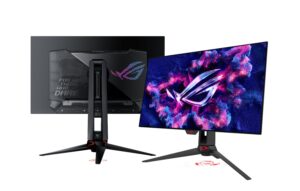
-
Display Specs: 27″, 2560×1440 WQHD, QD-OLED, up to 360Hz, native 10-bit color . GtG 0.03ms-class near-instant pixel response for blur-free motion. Trades 4K resolution for extreme refresh at 1440p.
-
Technologies: NVIDIA G-Sync + AMD FreeSync Premium compatible. HDMI 2.1 for 1440p high-refresh consoles; DP1.4 bandwidth is ample at 1440p. Built-in KVM and USB hub for multi-device workflows . HDR10, wide gamut (~99% DCI-P3).
-
Design: ROG Strix sci-fi look with three-side slim bezels for multi-display. Backlit ROG eye logo and RGB ring; fully adjustable stand and VESA mount. Thermal module helps maintain OLED stability during long high-refresh sessions.
-
Pros & Cons: One of the fastest 1440p displays: 360Hz + OLED’s near-zero persistence and superb contrast . Vibrant colors and deep blacks excel in dark rooms. Cons: no DisplayPort 2.1 (not fully “future-proof”); OLED blacks can tint in bright light ; still pricey and needs screen protection for static UI.
-
Price & Timing: Upper-end esports display; about US$1000 (launched mid-2024).
-
Best For: Response-time-critical esports (FPS, fighters) with 360Hz advantage; also cinematic single-player thanks to OLED contrast. Best in dimmer rooms.
3. LG UltraGear 27GR95QE-B (LG)

-
Display Specs: 27″ (26.5″ viewable), 2560×1440 QHD, WRGB OLED, 240Hz, 0.03ms GtG . Near-infinite contrast; native contrast ~1,500,000:1; pure blacks. 10-bit with 98.5% DCI-P3 for vivid color.
-
Technologies: NVIDIA G-Sync Compatible + AMD FreeSync Premium. HDR10 certified; peak ~800–1000 nits (3% window). Two HDMI 2.1 + one DP 1.4; USB 3.0 hub. DTS Headphone:X out . Often two-year OLED panel warranty (region dependent).
-
Design: UltraGear race-car aesthetic; hexagonal RGB “Sphere Lighting” on the back. Height/tilt and VESA mount. Flat panel with ultra-thin bezels; active cooling for sustained runs.
-
Pros & Cons: Ultra-fast motion and beautiful image quality earned strong praise . 240Hz + OLED = elite clarity; contrast and wide gamut beat LCDs . Cons: potential OLED retention; full-screen SDR brightness ~250 nits; HDR peaks are small-window dependent.
-
Price & Timing: MSRP US$999 (Jan 2023); street often $600–800 .
-
Best For: Speed + fidelity in one. Great for esports and AAA immersion; thrives in darker rooms. Also fine for color-sensitive work.
4. ASUS ROG Swift PG27AQN (ASUS)

-
Display Specs: 27″, 2560×1440 QHD, Fast IPS, 360Hz, 1ms GtG . First monitor to bring 360Hz to 1440p; 27″ increases immersion .
-
Technologies: NVIDIA G-Sync module with Reflex Analyzer for latency measurement . Adaptive-Sync/FreeSync compatible. ULMB 2 strobing at 360Hz for top-tier motion clarity . DP 1.4 (DSC for 1440p/360) and HDMI 2.0; USB hub and audio out.
-
Design: ROG Swift cyber look with backlit logo; includes ROG Desk Mount Kit clamp . Fully adjustable stand; slim-bezel tri-sides; big vents for the G-Sync module.
-
Pros & Cons: Esports-first: 360Hz at 1440p gives sharper image and broader view with extremely low latency and blur . Tests show excellent motion handling and very low input lag . Cons: Fast IPS contrast ~1000:1; HDR limited (HDR400) without local dimming ; minor brightness/color shifts at extreme angles .
-
Price & Timing: About US$1050 (early 2023) .
-
Best For: Pro esports and high-end FPS/racing where every ms counts. Needs top GPU for max frames. If deep blacks/HDR are vital, look to OLED/Mini-LED.
5. ASUS ROG Swift 360Hz PG259QNR (ASUS)
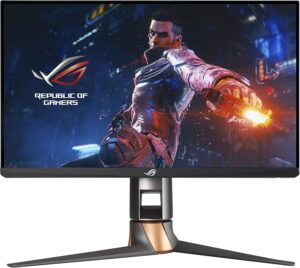
-
Display Specs: 24.5″, 1920×1080 FHD, Fast IPS, 360Hz, 1ms GtG . Among the first 360Hz monitors, built for pro-level response at 1080p.
-
Technologies: NVIDIA G-Sync module; Adaptive-Sync (FreeSync) compatible . HDR400 (basic). NVIDIA Reflex Latency Analyzer built-in . ULMB strobing at lower fixed refresh. DP 1.4, HDMI 2.0, USB 3.0 hub.
-
Design: Classic ROG styling; backlit emblem and vents. Includes ROG desk clamp; fully adjustable stand + VESA. Three-side slim bezel for dual setups.
-
Pros & Cons: Ultra-high refresh for buttery esports; Reflex Analyzer helps tune latency . IPS gives better color than TN. Cons: 1080p is purpose-built for esports; contrast lower than VA/OLED; HDR limited; premium pricing vs 240Hz.
-
Price & Timing: Launched ~US$699 (2020); now ~US$500.
-
Best For: Esports tournaments/training (CS:GO, Valorant). Pair with a second display for media/creation if needed.
6. Dell Alienware AW2524H (Alienware)
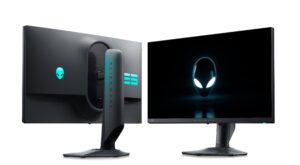
AW2524H is the world’s first mass-market 500Hz gaming monitor, engineered for pro esports. Image shows Alienware AW2524 series hardware.
-
Display Specs: 24.5″, 1920×1080 FHD, Fast IPS, native 500Hz (OC), 0.5ms GtG . Unprecedented motion clarity and responsiveness.
-
Technologies: NVIDIA G-Sync Ultimate module with ULMB 2 strobing at 500Hz (brightness ~270 nits) . Adaptive-Sync compatible. Two DP 1.4 + one HDMI 2.1 (HDMI up to 240Hz). USB 3.2 hub. Reflex Analyzer built-in. (Note: AW2524H = G-Sync module; AW2524HF = FreeSync version.)
-
Design: Lunar Dark Gray + black Alienware look; glowing alien head logo and “25” badge. Solid, ergonomic stand (height/tilt/pivot), VESA 100×100, headset hook on the left.
-
Pros & Cons: Record-breaking refresh: 500Hz yields ~2ms lower end-to-end latency vs 360Hz in tests . IPS color/contrast better than old TNs . Cons: very expensive and niche; needs monster CPU/GPU to realize benefits . Gains over 360Hz are smaller for non-pros.
-
Price & Timing: Launch US$829 (2023) ; HF version ~US$650. H version still ~US$700+.
-
Best For: Top-tier FPS pros with cutting-edge rigs (CS2, Valorant). Overkill for casuals; not media-focused at 1080p/24.5″.
7. BenQ ZOWIE XL2566K (BenQ)

-
Display Specs: 24.5″, 1920×1080 FHD, TN, 360Hz, 0.5ms GtG. Flagship ZOWIE built for native speed; TN offers inherently low latency.
-
Technologies: To minimize latency, XL2566K does not support Adaptive-Sync. Core feature is DyAc+ backlight strobing to reduce motion blur and clarify recoil patterns in shooters . Gaming tweaks include color temp, black equalizer. Two DP 1.4 + two HDMI 2.0. Includes S-Switch puck and shielding hoods.
-
Design: Pragmatic black matte chassis; attachable side shields. Compact base for more mouse room; fast-adjust stand (height/tilt/swivel) and quick release. 5-way OSD joystick + S-Switch for rapid presets; height scale marks to replicate settings at events.
-
Pros & Cons: In real competition, 360Hz + DyAc+ yields near-no-blur tracking; beloved by pros in CS:GO/APEX etc. Ultra-low input lag. Cons: TN color/viewing angles trail IPS/OLED; 1080p is purely practical; no Adaptive-Sync (tearing possible if frames dip). Built for winning, not looks.
-
Price & Timing: ~US$599 at 2022 launch; now around US$500.
-
Best For: Pro FPS teams and training facilities. If every millisecond matters, it delivers. For rich color/media, consider a second IPS/OLED display.
8. Dell Alienware AW3423DW (Alienware)
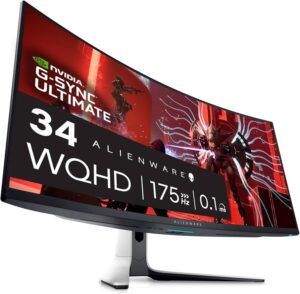
-
Display Specs: 34.18″, 3440×1440 UWQHD (21:9), QD-OLED curved (1800R), 175Hz native, 0.1ms GtG. First QD-OLED monitor combining self-emissive pixels with quantum dots.
-
Technologies: NVIDIA G-Sync Ultimate; DisplayHDR True Black 400. 99.3% DCI-P3, 10-bit; HDR peaks up to 1000 nits (3% window) . Two HDMI 2.0 (to 100Hz) + one DP 1.4; 4×USB 3.2 Gen1 hub. Fan cooling and OLED care tools (pixel refresh, move protection).
-
Design: Iconic white/black Alienware shell with glowing alien logo and “34” badge. 1800R curve for immersion. Height/tilt/swivel stand; VESA adapter cover included.
-
Pros & Cons: Image + speed together: near-infinite contrast and deep blacks of QD-OLED; 175Hz/0.1ms keeps motion sharp . Vivid, accurate color; 21:9 cinematic immersion. Cons: burn-in risk (Dell offers 3-yr panel warranty); small fan noise; full-white brightness ~250 nits so prefers dimmer rooms.
-
Price & Timing: US$1,299 at 2022 launch; now ~US$1000–1100.
-
Best For: Ultimate immersion in RPG/sim/films; 175Hz is ample for competitive play. Great productivity width. Use with some room light control.
9. LG UltraGear 34GR95QE-B (LG)

-
Display Specs: 34″, 3440×1440 UWQHD, 800R deep-curve OLED, 240Hz, 0.03ms GtG . 21:9 self-emissive with highly enveloping curve.
-
Technologies: G-Sync Compatible + FreeSync Premium Pro. VESA DisplayHDR™ True Black 400; HDR peak ~1300 nits (3% window) . 99% DCI-P3; 10-bit. Two HDMI 2.1 + one DP 1.4; DTS Headphone:X jack. PIP/PBP, crosshair overlay.
-
Design: UltraGear red/black with “Sphere Lighting” RGB ring. Height/tilt stand (no pivot on ultrawides). Ultra-thin bezels; tidy cable clip; often two-year OLED panel warranty (region).
-
Pros & Cons: Among the best ultrawides: 240Hz + OLED’s instant response; 800R curve heightens wraparound feel . Gorgeous color and HDR. Cons: demands strong GPU for 3440×1440/240; OLED care required; full-screen SDR brightness modest; 21:9 support varies in some esports/streaming.
-
Price & Timing: US$1,299 (2023); now ~US$1100.
-
Best For: All-round flagship for racers/flight sims and AAA epics. 21:9 films fill the screen. Pair with high-end PC; run pixel refresh periodically.
10. Samsung Odyssey Neo G8 (G85NB) (Samsung)
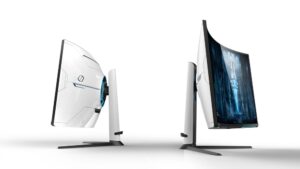
-
Display Specs: 32″, 3840×2160 4K, 1000R curved VA, 240Hz, 1ms GtG . First 4K/240Hz monitor with Odyssey’s signature 1000R wrap.
-
Technologies: Mini-LED with 2048 local dimming zones; contrast up to 1,000,000:1 ; DisplayHDR 2000 with up to 2000-nit peaks . FreeSync Premium Pro + G-Sync Compatible . Two HDMI 2.1 + one DP 1.4 (DSC) for 4K/240. PBP/PIP and CoreSync RGB.
-
Design: Space-age Odyssey with white rear shell and ring RGB “Infinity Core.” Big but stable stand (height/swivel/tilt/pivot). Heftier chassis due to Mini-LED array; cable cover for clean routing.
-
Pros & Cons: Combines ultra-high res and ultra-high refresh . HDR is spectacular (deep blacks + 2000-nit highlights) . 1000R curve for intense presence. Cons: some reviews noted VRR flicker at low framerates and slight diagonal artifacts in near-black ; 4K/240Hz stresses GPUs; VA can show faint black smearing in rare cases.
-
Price & Timing: Launched US$1499 (2022); now ~US$1000+. Neo G7 offers 165Hz at lower cost.
-
Best For: Ceiling-spec HDR gaming with RTX 4080/4090-class rigs. Epic for racers/sims; curve requires desk depth and adaptation for office work.
11. Dell S2721DGF (Dell)
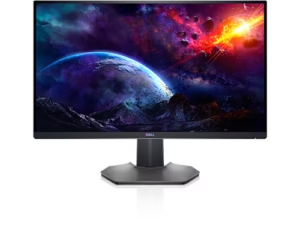
-
Display Specs: 27″, 2560×1440 QHD, Fast IPS (LG Nano IPS), 165Hz native (OC 170Hz), 1ms GtG. A hugely popular mid-range gaming monitor .
-
Technologies: FreeSync Premium Pro + G-Sync Compatible . HDR400 (no local dimming). 98% DCI-P3; 10-bit (FRC). Two HDMI 2.0 + one DP 1.4; 4×USB 3.0 hub; Dell Display Manager for window presets.
-
Design: Minimal slim-bezel three sides; matte black with blue vent accent. Full ergonomics incl. pivot; easy tool-less mount; VESA 100×100.
-
Pros & Cons: The “sweet-spot” pick: great speed + image at a fair price . Nano IPS color and uniformity are strong . Cons: HDR limited; IPS glow/1000:1 contrast typical; no hardware LUT. Still excellent for most gamers.
-
Price & Timing: Launched ~US$569 (2020); now often US$300–350 .
-
Best For: Do-it-all main monitor. 1440p is sharp yet GPU-friendly; 165Hz handles all genres. Good casual media/creation, too.
12. AOC 24G2 (AOC)

-
Display Specs: 23.8″, 1920×1080 FHD, IPS, 144Hz (newer 24G2/SP up to 165Hz), 1ms MPRT/4ms GtG. A long-time budget legend since 2019 .
-
Technologies: FreeSync Premium + G-Sync Compatible. 110% sRGB vivid color . AOC Dial Point crosshair, shadow control. Two HDMI 1.4, one DP 1.2, one VGA; built-in 2W×2 speakers.
-
Design: Three-side slim bezels for multi-display. Matte black with red accents; compact V-base. Rare at this price: full ergonomic stand (height/swivel/tilt/pivot) + VESA. OSD buttons underneath.
-
Pros & Cons: Low price, well-rounded: 144–165Hz + IPS viewing and color . Good out-of-box accuracy; ~1000:1 contrast. Minor blur/overdrive tuning needed for extremes; 1ms MPRT via strobe lowers brightness. 1080p is modest for work but easy on GPU.
-
Price & Timing: Launch US$199; now ~US$150 (promo $130 or less) .
-
Best For: Budget high-refresh upgrade—students, cafes, or secondary setups. Great entry to 144Hz gaming.
13. Gigabyte M27Q X (Gigabyte)
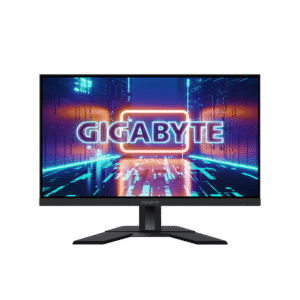
-
Display Specs: 27″, 2560×1440 QHD, Fast IPS, 240Hz, 0.5ms MPRT/1ms GtG. Successor to M27Q (170Hz), fixes subpixel to standard RGB (old was BGR) .
-
Technologies: FreeSync Premium + G-Sync Compatible, 48–240Hz with LFC. HDR400; 95% DCI-P3 . Aim Stabilizer Sync allows blur reduction strobe alongside VRR. Two HDMI 2.0 + one DP 1.4; USB hub; KVM switching .
-
Design: Minimal matte black; tri-micro bezels. Stand offers height/tilt only (no swivel/pivot); VESA mount ready. OSD joystick and OSD Sidekick software.
-
Pros & Cons: High refresh + 1440p at a sharp price; 240Hz trendsetter . Fast IPS motion; wide, accurate color. KVM is handy. Cons: HDR entry-level (no local dimming); ~1000:1 contrast; no speakers; limited stand ergonomics; tune overdrive to avoid minor overshoot at extremes .
-
Price & Timing: Launched US$429 (2022); now ~US$350 .
-
Best For: 240Hz 1440p mainstream gamers—Warzone/Apex—balancing frames and fidelity; great for PC + laptop KVM users.
14. Samsung Odyssey G7 C27G75T (Samsung)

-
Display Specs: 27″, 2560×1440 QHD, 1000R curved VA, 240Hz, 1ms GtG. A 2020 leader in high-performance curved monitors.
-
Technologies: FreeSync Premium Pro + G-Sync Compatible . HDR600 (edge-lit local dimming ~8 zones), up to 600 nits. Quantum-dot wide gamut (125% sRGB). Two DP 1.4 + one HDMI 2.0; USB 3.0 hub; Core Lightning RGB.
-
Design: Futuristic styling; 1000R curve for powerful wrap. Rear ring light; sculpted stand (height/swivel/tilt/pivot). Anti-glare matte.
-
Pros & Cons: Known for high contrast + high refresh. VA native ~2500:1 beats IPS in dark scenes ; 240Hz with well-tuned response competes with IPS speed . Early firmware scanlines were patched later. HDR limited by few zones; VA has rare black smear; viewing angles narrower than IPS.
-
Price & Timing: Launch US$699 (2020); now ~US$500.
-
Best For: Heavy gamers wanting immersion + speed. Great for FPS and neon-drenched RPGs. A mature, value buy vs newer Neo models.
15. Gigabyte M28U (Gigabyte)
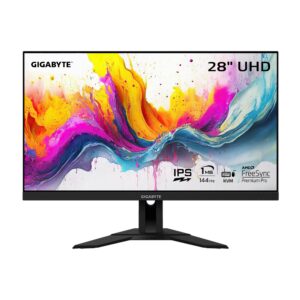
-
Display Specs: 28″, 3840×2160 4K, IPS, 144Hz, 2ms GtG. Famous budget 4K144 pioneer under US$600 ; 157 PPI sharpness.
-
Technologies: FreeSync Premium Pro + G-Sync Compatible (48–144Hz LFC). HDR400 (no local dimming), ~300–350 nits . 90% DCI-P3. Two HDMI 2.1 (4K120 for PS5/XSX) + one DP 1.4 DSC; USB hub; KVM switching . Dual 3W speakers.
-
Design: Minimal M-series look; slim bezels. Height/tilt stand (no swivel/pivot); VESA mountable. OSD joystick + Sidekick app; a bit of wobble when adjusted.
-
Pros & Cons: 4K + 144Hz at a much lower cost . Sharp image, solid color accuracy (factory ΔE<2). Console-friendly HDMI 2.1 with VRR. KVM useful. Cons: Basic HDR; ~1000:1 contrast; overdrive may add slight overshoot at extremes.
-
Price & Timing: US$599 (2021) ; now US$450–500.
-
Best For: PC + console users seeking a desk-friendly 28″ 4K120/144 screen for AAA titles and general creation work.
16. Sony INZONE M9 (Sony)
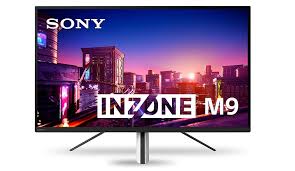
-
Display Specs: 27″, 3840×2160 4K, IPS, 144Hz (OC 160Hz), 1ms GtG. Sony’s flagship INZONE with FALD HDR for PS5 + PC .
-
Technologies: G-Sync Compatible, HDMI Forum VRR, FreeSync. Full-Array Local Dimming with 96 zones; DisplayHDR 600 . Peaks ~600 nits. 95% DCI-P3; 10-bit. Two HDMI 2.1 (PS5 4K120 VRR), one DP 1.4; USB hub. PS5 features: Auto HDR Tone Mapping and Auto Genre Picture Mode. Built-in KVM and FPS tools.
-
Design: PlayStation-inspired white/black with offset tri-pod stand for wider keyboard space . Height/tilt only (no swivel/pivot) . Rear ambient ring light.
-
Pros & Cons: Excellent HDR with Sony tuning: 96-zone FALD yields deeper blacks and brighter highlights than typical IPS, with restrained blooming in games . Great factory color. Cons: Limited stand ergonomics ; slightly higher input lag than some peers but still low (~5ms). Desktop dimming behavior can be noticeable; price is premium.
-
Price & Timing: US$899 (mid-2022) ; later 160Hz revision ~US$799.
-
Best For: PC + PS5 households seeking one screen for both. Strong HDR in games and good for media/creation. If esports-only, faster/cheaper 1440p options exist.
17. Dell Alienware AW2723DF (Alienware)
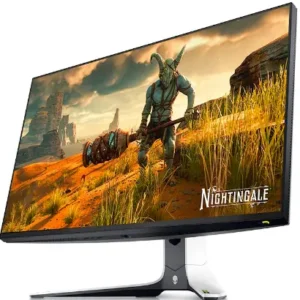
-
Display Specs: 27″, 2560×1440 QHD, Nano IPS, 240Hz native (OC 280Hz), 1ms GtG . Successor to AW2721D with higher refresh and HDR.
-
Technologies: FreeSync Premium Pro + G-Sync Compatible, 48–280Hz . DisplayHDR 600 with 16-zone direct-lit local dimming . 100% sRGB, 95% DCI-P3 ; sRGB clamp mode. Two HDMI 2.0, one DP 1.4, 4×USB 3.2; audio out; AlienFX RGB.
-
Design: Latest Alienware “Lunar” language with LED loop and glowing logo. Fully ergonomic, refined build; OSD joystick + 4 hotkeys; software control via Alienware Command Center.
-
Pros & Cons: A balanced all-rounder: 280Hz speed, vivid Nano IPS color, and meaningful HDR600 with some dimming. Cons: Contrast still ~1000:1 vs OLED/VA; HDMI 2.0 only (fine for 1440p). Slightly pricier than generic brands; strong service/warranty.
-
Price & Timing: US$649.99 (late 2022); often ~US$600 .
-
Best For: Balanced enthusiasts—competitive shooters and HDR-tinged single-player alike; also handy for creation with sRGB/DCI-P3 modes.
18. Acer Nitro XV272U KV (Acer)
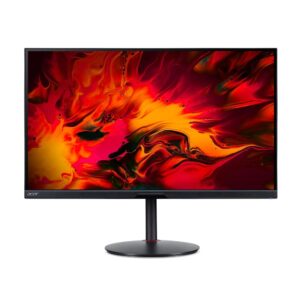
-
Display Specs: 27″, 2560×1440 QHD, IPS, 170Hz (144Hz OC), 0.5ms MPRT/1ms GtG. Praised for factory calibration and value; a top budget 1440p pick by Rtings .
-
Technologies: FreeSync Premium + G-Sync Compatible. HDR400, ~400-nit peak; no local dimming. 95% DCI-P3; 8-bit+FRC. Ambient light sensor for auto brightness (VisionCare). Two HDMI 2.0, one DP 1.4; 4×USB 3.0 hub; low blue light and flicker-free.
-
Design: Clean Nitro look, three-side slim bezel, matte panel. Large round base; fully ergonomic (height/swivel/tilt/pivot). OSD joystick; practical aesthetics.
-
Pros & Cons: Excellent image quality and careful tuning: sRGB mode ships well-calibrated (ΔE ~1.x) ; slightly higher-than-typical IPS contrast (~1200:1) . 170Hz feels smooth; minimal overshoot. Cons: Entry-level HDR; 8bit+FRC and 400 nits limit HDR impact.
-
Price & Timing: US$399 at 2020 launch; now US$250–300 .
-
Best For: Mainstream gaming + daily work. 1440p/170Hz fits most titles; color accuracy and eye-care suit long sessions. For stronger HDR or 240Hz, spend more.
19. ViewSonic Elite XG2431 (ViewSonic)
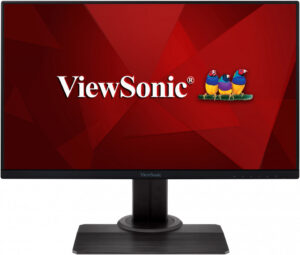
-
Display Specs: 24.5″ (marketed 24″), 1920×1080 FHD, IPS, 240Hz, 0.5ms MPRT / 1ms GtG. Lauded for motion blur control; Blur Busters Approved 2.0 .
-
Technologies: FreeSync Premium (48–240Hz) + G-Sync Compatible. PureXP strobing tuned with Blur Busters for near-CRT clarity across refresh rates . ~104% sRGB. Two HDMI 2.0 + one DP 1.4; dual USB 3.0; headphone hanger. ELMB-style blur reduction can work with Adaptive-Sync concurrently.
-
Design: Elite series with slim bezels and customizable rear RGB. Includes side shields and speaker hanger. Full ergonomic stand with cable-routing. OSD via joystick/hotkeys; Elite Display Controller software.
-
Pros & Cons: Best-in-class blur reduction: PureXP gives razor-sharp motion from 60–240Hz —huge for rhythm/FPS players. Low input lag. Cons: 1080p feels dated for non-esports; strobing reduces brightness and needs user tuning; no HDR.
-
Price & Timing: US$349 (2021) ; now ~US$299.
-
Best For: Hardcore esports or blur-sensitive users (CS:GO pros, fighting games, rhythm games). If you prize motion clarity above all, this delivers.
20. Dell S3222DGM (Dell)
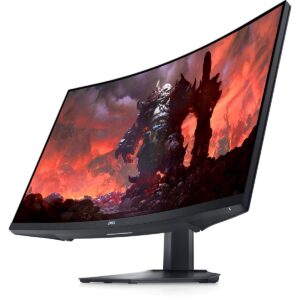
Dell S3222DGM uses a 32″ curved VA panel and has been a hot value choice. 1440p resolution + 165Hz refresh deliver excellent gaming at a friendly price. Image shows the S3222DGM’s curve and clean design.
-
Display Specs: 31.5″, 2560×1440 QHD, VA curved (1800R), 165Hz, 4ms GtG. Known for big size + high refresh + great price .
-
Technologies: FreeSync Premium + G-Sync Compatible (48–165Hz). No formal HDR (software HDR only), focused on SDR gaming. 122% sRGB / 85% DCI-P3 coverage . Two HDMI 2.0 + one DP 1.2; includes both cables . Low blue light and flicker-free.
-
Design: Simple & understated Dell look—matte black with minimal accents. 1800R curve; stand adjusts height/tilt (no swivel/pivot). Easy tool-less mount; VESA 100×100. Solid build over flashy RGB.
-
Pros & Cons: Very high contrast and immersive large curve. VA ~3000:1 excels in dark scenes . 165Hz feels smooth, motion near 1ms MPRT when tuned. Factory color is good. Cons: No true HDR or local dimming; minor VA dark-level smearing in edge cases; lacks USB hub. Considering price, hard to fault.
-
Price & Timing: Launched ~US$329 (2021) ; promos often under US$250. A longtime bestseller.
-
Best For: Big-screen on a budget. Immersive for AAA and MMOs; 165Hz fine for shooters/racers. Also spacious for productivity—ensure desk depth for 32″.




